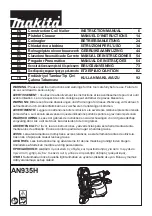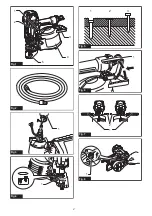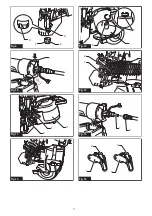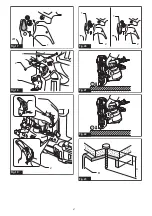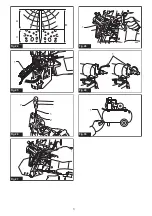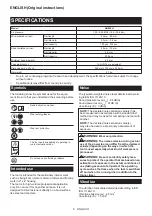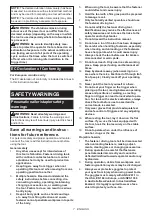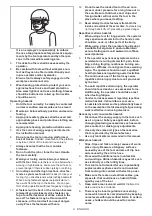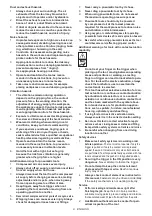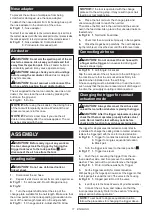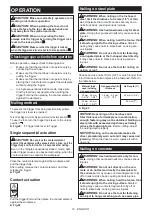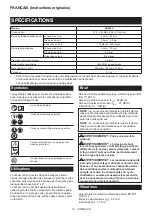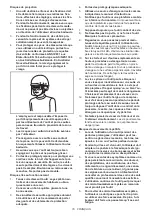
11 ENGLISH
Nose adapter
To prevent the surface of workpiece from being
scratched or damaged, use the nose adapter.
To detach the nose adapter from its housing base, pull
the nose adapter in the direction of the arrow.
►
Fig.8:
1.
Nose adapter
To attach the nose adapter to the contact element, press it onto
the contact element until the recessed parts in four places inside
the nose adapter fit in four protrusions of the contact element.
►
Fig.9:
1.
Nose adapter
2.
Contact element
3.
Protrusion
4.
Recessed part
Air duster
CAUTION:
Do not aim the ejection port of the air
duster to someone. Also, keep your hands and foot
away from the ejection port.
If the air duster button is
accidentally pushed, it may cause a personal injury.
CAUTION:
Always check your surroundings
before using the air duster.
Blown dust or objects
may hit someone.
CAUTION:
Do not connect or disconnect the
air hose while pushing the air duster button.
The air supplied to the tool can also be used as an air
duster. You can clean the work area by pressing the
button on the grip end.
►
Fig.10:
1.
Button
NOTICE:
After using the air duster, the driving force
of the tool will temporarily decline. Wait until the air
pressure recovers in this case.
NOTICE:
Perform a test blow if you use the air
duster immediately after the oil was applied. The oil
may be sprayed with the air.
ASSEMBLY
CAUTION:
Before carrying out any work on
the tool, always lock the trigger by turning the
trigger lock lever to the lock position , and
disconnect the air hose from the tool.
Loading nailer
CAUTION:
Do not use deformed nails or
linked sheet.
1.
Disconnect the air hose.
2.
Depress the latch lever and open the door and magazine cap.
►
Fig.11:
1.
Latch lever
2.
Door
3.
Magazine cap
►
Fig.12
3.
Turn the adjust shaft and set the step of the
change plate suitable for the nail length. Make sure that
the arrow points to the corresponding graduation incre-
ment of the nail length marked on the adjust shaft.
►
Fig.13:
1.
Change plate
2.
Adjust shaft
3.
Arrow
NOTICE:
If the tool is operated with the change
plate set to the wrong step, it may result in poor nail
feeding or tool malfunction.
4.
Place the nail coil over the change plate and
uncoil enough nails to reach the nail rail.
Then place the first nail in the nail rail and the second
nail in the feed claw. Also, place other uncoiled nails on
feeder body.
►
Fig.14:
1.
Nail rail
2.
Feed claw
5.
Check that the nail coil is set properly in the magazine.
6.
Close the magazine cap carefully. Then with depress-
ing the latch lever, close the door until the latch lever locks.
Connecting air hose
CAUTION:
Do not connect the air hose with
a finger on the trigger.
An unexpected driving will
cause serious injury.
►
Fig.15:
1.
Air fitting
2.
Air socket
Slip the air socket of the air hose onto the air fitting on
the tool. Be sure that the air socket locks firmly into
position when installed onto the air fitting.
A hose coupling must be installed on or near the tool in
such a way that the pressure reservoir will discharge at
the time the air supply coupling is disconnected.
Changing the trigger for contact
actuation mode
CAUTION:
Always disconnect the air hose and
unload the tool with nails before replacing the trigger.
CAUTION:
After the trigger replacement, always
check that the tool operates properly before actual
work. Do not load the tool with any nails before
checking the function to avoid unexpected nailing.
The trigger for single sequential actuation mode is facto-
ry-installed. To change the nailing mode to contact actuation,
replace the trigger part with the one for contact actuation.
►
Fig.16:
1.
Trigger for contact actuation
2.
Silver part
3.
Trigger for single sequential actuation
4.
Black part
1.
Turn the trigger lock lever to the lock position .
►
Fig.17:
1.
Trigger lock lever
2.
Push the pin securing the trigger from the ure-
thane washer side, and then remove the urethane
washer. Then pull out the pin and remove the trigger.
►
Fig.18:
1.
Pin
2.
Urethane washer
3.
Trigger
3.
Set the trigger assembly for contact actuation.
With pushing in the hinged part inward, set the trigger so that
the hinged part is under the rod of the valve in the housing.
►
Fig.19:
1.
Hinged part
2.
Rod of the valve
4.
Insert the pin to the hole and secure it by urethane washer.
5.
Connect the air hose, and make sure that the
tool operates properly. Refer to the section “Checking
proper action before operation”.
NOTE:
To set back to single sequential actuation,
follow the procedures for changing the trigger above.

